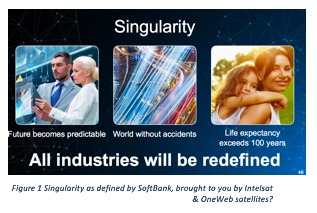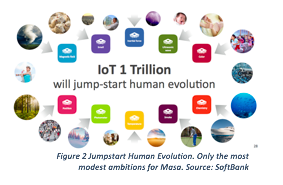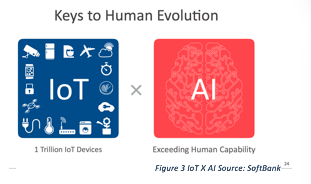Space 2.0 Bubble, or Industrial Revolution?
The potential merger between Intelsat and OneWeb has rightly captured significant headlines in the satellite telecom world. Timing has played a role, with the talk of Satellite 2017 last week in DC centering around this deal, among other things, but conference notwithstanding, this is huge news. Since the announcement, we have seen a number of opinions and reactions by the industry at large, both positive and negative, which is to be expected given the number of “what ifs?” and the dramatically different technologies involved in the potential tie-up. NSR believes it is helpful to take a step back and understand some fundamentals about this deal, before making any conclusions on what this might mean for Intelsat or OneWeb, two very small pieces in a multi-billion dollar much larger puzzle.
Masa Scale
One cannot understand the implications of Intelsat and OneWeb’s proposed tie-up through a satellite telecom lens alone. What we are witnessing is a single piece in a puzzle being put together by Masayoshi Son (Masa), the CEO of SoftBank and one of the most “cavalier” business personalities of the tech world. A man known for making big bets and sticking to them (even when they lose), Masa’s role in this potential merger, and his ambitions beyond the immediate term, cannot be understated. What makes Masa so crucially important in this transaction? The fact that he is at the helm of a $100 billion tech fund, and that this multi-billion dollar transaction is actually one of several multi-billion dollar transactions made to date, as part of a vision of the technological future of humanity (and devices). That SoftBank’sfund is called the “Vision Fund” is no accident—Masa has a vision to become “over the next decade…the biggest investor in the technology sector”, andIntelsat and OneWeb are but a part of this. Let us make no mistake about it, this is an idea that has involvement from the highest levels of power on both sides of the Pacific,
 with Masa, one of Japan’s richest men, even meeting with President Donald Trump of the United States to talk about his long-term vision (and how it would lead to 50,000 new jobs in the U.S…Rule #1 when you have enormous and outlandish ambitions: it helps to collect a few “Trump” cards).
with Masa, one of Japan’s richest men, even meeting with President Donald Trump of the United States to talk about his long-term vision (and how it would lead to 50,000 new jobs in the U.S…Rule #1 when you have enormous and outlandish ambitions: it helps to collect a few “Trump” cards).
So at this point, we have Masa at the helm of a $100 billion tech fund with buy-ins from the Saudi Arabian Sovereign Wealth Fund, Apple, Oracle & Qualcomm (the latter also being a OneWeb investor), and Foxconn, and a mandate to “further accelerate the Information Revolution by contributing to its development”, in the words of Masa. With this in mind, let us examine the steps the fund—and Masa—have taken up to this point to put together the puzzle pieces of the next generation of technological (r)evolution.
A Technological ARMs Race
With a mandate to build the future of technology, and a bank account with 12 digits, the possibilities are endless. However, if one were to, from scratch, think about how exactly to build the future of technological advancement, one might start by cobbling together several different companies with different specialties. We have all read the stories of a world dominated by M2M/IoT, driverless cars, the cloud, and a 5G revolution. Whether or not this ends up being an addressable market for satellite, it appears to be a future we are moving towards, and it seems to be the mission of the SoftBank Vision Fund and Masa to build this future in their image.
If one wanted to do this, one might, for example, buy a semiconductor company, a robotics company, and perhaps decide to go buy an investment bank to help with all your investments, all of which SoftBank has done over the past year or so. One might even start building partnerships with automakers to help develop smarter cars that allow cars to “interact with their drivers via cloud-based technology”, another boxed ticket by SoftBank when they made an agreement with Honda, just days after buying the UK’s ARM in July 2016.
Looking towards the next piece(s) of the puzzle, in bringing about an IoT/M2M/connected world revolution, one would need to find a way to cheaply cover the entire world, or at least, “99% of the world’s populated regions”. This brings us to the value of Intelsat, and the merger that we have been so frequently talking about lately.
The Intelsat and OneWeb Play—Really Connecting the Other 3 Billion
Being involved in the relatively stable, slow-moving satellite telecom industry, one might find it surprising that we could be involved what might be described as the next industrial revolution. However, SoftBank has left us a number of hints on where the Intelsat and OneWeb pieces might fit into this bigger puzzle. This includes a number of extraordinary comparisons in a presentation made by Masa in February 2017, which included the IoT to the first animals that developed eyes (i.e., eyes allowed animals to sense, the IoT will allow us to sense and track), and a claim that by 2035, there would be a total of 1 trillion IoT devices globally (that is, trillion with a T). This “IoT 1 Trillion” idea will lead to an “Information Revolution—Happiness for Everyone”, in the eloquent words of Mr. Son.
one might find it surprising that we could be involved what might be described as the next industrial revolution. However, SoftBank has left us a number of hints on where the Intelsat and OneWeb pieces might fit into this bigger puzzle. This includes a number of extraordinary comparisons in a presentation made by Masa in February 2017, which included the IoT to the first animals that developed eyes (i.e., eyes allowed animals to sense, the IoT will allow us to sense and track), and a claim that by 2035, there would be a total of 1 trillion IoT devices globally (that is, trillion with a T). This “IoT 1 Trillion” idea will lead to an “Information Revolution—Happiness for Everyone”, in the eloquent words of Mr. Son.
It should therefore be becoming increasingly obvious the role that Intelsat, and the future iteration of OneWeb, would play in this game plan; seamless connectivity globally for more devices than we could possibly comprehend, all coordinated in one huge network encompassing hundreds of billions of IoT devices, managed by Artificial Intelligence.
And, assuming that Intelsat and OneWebare indeed components in what is a much, much larger ambition by Masa, then it is also safe to say that the success or failure is based less on the individual meri ts of Intelsat and OneWeb as companies, but rather, on the merits of Masa’s idea as a whole. Whether intersatellite links ends up being feasible is less important when there is $100 billion in R&D standing behind the company, and whether OneWeb or Intelsat sees a bigger piece of the funds coming in from newly sold capacity likewise is less important. More important will be whether the world—and technology therein—really does play out in the way that Masa believes. A host of challenges absolutely remain on the satellite side, with these including, but not limited to:
ts of Intelsat and OneWeb as companies, but rather, on the merits of Masa’s idea as a whole. Whether intersatellite links ends up being feasible is less important when there is $100 billion in R&D standing behind the company, and whether OneWeb or Intelsat sees a bigger piece of the funds coming in from newly sold capacity likewise is less important. More important will be whether the world—and technology therein—really does play out in the way that Masa believes. A host of challenges absolutely remain on the satellite side, with these including, but not limited to:
-
- OneWeb securing landing rights in every country in which they want to do business
- Kymeta (or someone else) developing a terminal that is cost effective (cheap), portable, and easy to install, and (perhaps most important) licensed to operate in each country
- Technological issues with frequency interference
- Distribution networks appearing or being integrated into the company
- Intelsat’s finances remaining workable
But these challenges ultimately all seem somewhat smaller in the context of a $100 billion fund that has, among other things, purchased the UK chip maker ARM for approximately 15x the amount invested into Intelsat, or alternatively, invested >$1 billion into a startup with zero revenues at this point (for those who do not like links, the startup in question is OneWeb).
With all that said, in the context of the satellite industry, this deal appears to put Intelsat/OneWeb at a massive head start in terms of creating an “integrated system”. The talk last week at DC oftentimes centered on this idea of maintaining margin by integrating with service providers, equipment manufacturers, and the rest of the value chain. In this sense, contingent on a great many things above going right, Intelsat, OneWeb, and Kymeta, plus the above-mentioned partners in addition to Bharti Airtel, Coca Cola, Virgin, etc., appear to have the best shot at creating their version of humanity’s technological future inside a system that is more or less completely vertically integrated, with our friend Masa at the helm (sorry, Greg Wyler). Other potential pieces to this puzzle on the satellite side could even include SKY Perfect JSAT, a company with a long history of partnerships with Intelsat that include the two companies agreeing on a joint GEO-HTS (Horizons-3e), and with JSAT signing an interestingly similar deal with Kymeta just last week.
Bottom Line
Looking back at the first industrial revolution, the names Vanderbilt, Morgan, and Carnegie remain famous to this day for their contributions. With Masa having a 30-year plan for SoftBank, and with sovereign wealth funds thinking in decades, not years, the transformation described above will certainly not occur tomorrow. But it will occur. From the satellite operator perspective, this brings about a host of questions about how to best position themselves for this future. The addressable markets discussed by Son and Intelsat for this merger would seem to imply, for example, that SES may be correct in focusing their efforts on events like the Mobile World Congress, rather than Satellite 2017.
Which takes us back to the Intelsat-OneWeb announcement, and the Satellite 2017 conference shortly thereafter. The talk of the conference was big, integrated systems. Operators getting closer to the customer and finding ways to control the data they produce, with elements such as scalability and global coverage being crucial. With a potential 1 trillion devices on IoT by 2035 seeming a “not so crazy” claim (around 100 devices per person), the addressable market for data connectivity will be huge, and the role that satellite operators can play here is significant. The most critical question, therefore, is will the puzzle pieces fit together? At the end of the day, one must ask oneself, will this idea be the next dotcom bubble, or the next industrial revolution?







